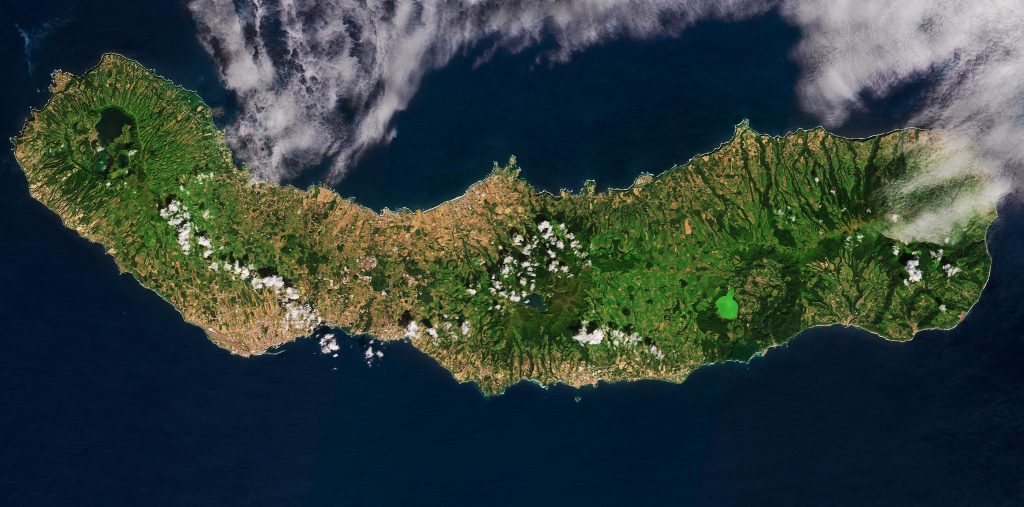I visited Portugal at the beginning of March and spent two nights in the Azores and three in Lisbon. It was at the start of the global pandemic and the exact worst time to get on an international flight. On the morning of the first full day of the trip, I woke up to news of the United States’ travel ban from Europe, a slew of flight cancellations, and a lot of anxiety. We decided to lay low for a bit and luckily none of our originally-booked flights were cancelled, Boston made it on the list of airports accepting flights from Europe, and we made it home healthy and on time.
The Azores are an autonomous region of Portugal located in the middle of the Atlantic Ocean. They are a volcanic archipelago of nine major islands and home to about a quarter of a million people. The Portuguese discovered and colonized the islands in the mid-15th century; there was no indigenous population.

We visited the island of São Miguel, the most populous island in the Azores and home to its capital city, Ponta Delgada. Nicknamed Ilha Verde, or the Green Island, São Miguel is extremely verdant. I experienced firsthand the rains that keep the island so lush, having visited in the peak of the rainy season aka the affordable flight season. Multiple locals boasted of how you can experience all four seasons in the Azores in one day, from sun to winds to rain. As a New Englander, I felt perhaps four seasons was kind of a stretch. I’ll give them two, three tops.
Ponta Delgada is situated in a developed area in the southwest of the island. The quaint, walkable city has a distinctive architectural style. Landmarks like the Portas da Cidade (City Gates) and the Igreja de São Sebastião are constructed out of white plaster and locally quarried black basalt. I also hiked around the Sete Cidades Massif, a water-filled volcanic caldera visible on the westernmost end of the island in the satellite image below. Also clearly visible is the striking green of Furnas Lake on the the south east side of the island.

On the big hiking day, we hired a taxi to take us from Ponta Delgada to Miradouro da Vista do Rei (King’s View viewpoint). If you couldn’t tell from the name, it’s a spot that’s supposed to have a pretty good view. While the weather was lovely during our drive, clouds formed at elevation and the rain started coming down as we arrived. The cab driver didn’t want to drop us there. We had to assure him that yes, indeed, we wanted to be left next to an abandoned hotel, miles from the nearest town, in the pouring rain. We hiked around the caldera to the town of Sete Cidades. I zipped my camera up in my not-that-waterproof-anymore jacket, pulled the hood up, and trudged on. While the hike wasn’t what I imagined it to be in the weeks leading up to the trip, I did manage to take a few nice shots for this album, including one or two rainbows.
Lagoa das Sete Cidades is the freshwater lake inside the volcanic crater. It’s made up of twin lakes, Lagoa Azul and Lagoa Verde, separated by a short manmade bridge. Legend has it a green-eyed princess met a blue-eyed shepherd and they fell in love. The king would not let his daughter marry the shepherd, so when the lovers had to part ways they cried, the princess’ green tears filling Lagoa Verde and the shepherd’s blue tears filling Lagoa Azul. My own tears aren’t brown, but I’ll buy it.
In Sete Cidades a man who worked at a market called us a taxi back to Ponta Delgada. When she finally arrived and got out to greet us, the mini-van started rolling down the street. I jumped back so it wouldn’t roll over my feet. The cabbie yelped, ran back around to the driver’s side and braked. When we got in, I was sure to buckle up. Though a terrible driver, her English was good and she enthusiastically talked to us about her island.
On the drive, we passed by a group of thirty or so Romeiros (pilgrims) on their week-long Romeira (pilgrimage) around the island. Our cabbie told about this annual tradition on São Miguel. Every February and March, men walk in groups around the circumference of the island clockwise praying in all of the Catholic churches, hermitages, and chapels along the way. They wear checkered shawls and flowered scarves and carry walking sticks and rosaries but no food or money, relying on the charity of locals for food and shelter. The tradition started in 1522, after a series of disastrous earthquakes and volcanic eruptions prompted religious leaders to organize the first procession in an attempt to seek divine protection. Most Azorean men participate in the pilgrimage at least once in their lives. Since the 500th anniversary of the pilgrimage is coming up soon in 2022, there is an application in the works for a UNESCO designation as Intangible Cultural Heritage.
AZORES, PORTUGAL

Azores Locator Map: Vzb83, AzoresLocation, CC BY-SA 3.0
São Miguel Satellite Image: Modified Copernicus Sentinel data (2016), processed by ESA, CC BY-SA 3.0 IGO